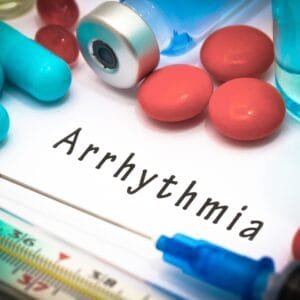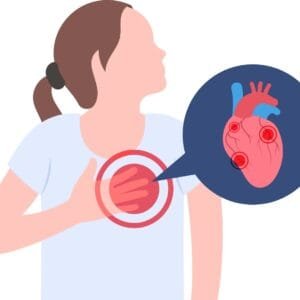Arrhythmias: Understanding Irregular Heartbeats
Arrhythmias are irregular heart rhythms that occur when the electrical impulses coordinating the heartbeats malfunction. This condition can cause the heart to beat too fast (tachycardia), too slow (bradycardia), or erratically. Arrhythmias may feel like a racing heart, fluttering, or pauses between beats. While some arrhythmias are harmless, others can lead to severe complications such as stroke, heart failure, or cardiac arrest.



What Are Arrhythmias?
Arrhythmias arise from disruptions in the heart’s electrical system, which regulates the rate and rhythm of heartbeats. They are categorized based on the heart rate and origin of the abnormal rhythm:
- Tachycardia: A heart rate exceeding 100 beats per minute.
- Bradycardia: A heart rate below 60 beats per minute.
- Atrial Arrhythmias: Abnormal rhythms originating in the upper chambers (atria), such as atrial fibrillation.
- Ventricular Arrhythmias: Originate in the lower chambers (ventricles), often more severe and life-threatening.
Causes of Arrhythmias
Several factors can trigger arrhythmias:
- Coronary Artery Disease (CAD): Reduced blood flow to the heart can disrupt its rhythm.
- High Blood Pressure: Strains the heart, causing electrical malfunctions.
- Electrolyte Imbalances: Potassium, calcium, and magnesium deficiencies can disrupt electrical signals.
- Heart Valve Disorders: Alter blood flow patterns, affecting rhythm.
- Substance Abuse: Alcohol, caffeine, and recreational drugs can trigger arrhythmias.
- Stress and Anxiety: Over-activation of the nervous system may lead to irregular heartbeats.
Symptoms of Arrhythmias
Arrhythmias can be asymptomatic or cause noticeable symptoms, including:
- Palpitations: A fluttering or pounding sensation in the chest.
- Dizziness or Lightheadedness: Due to inadequate blood flow to the brain.
- Shortness of Breath: Especially during exertion.
- Chest Pain or Discomfort: Often a sign of a serious arrhythmia.
- Fainting (Syncope): Caused by a sudden drop in blood pressure.
Types of Arrhythmias
Arrhythmias are classified based on their origin and impact on heart rate:
- Atrial Fibrillation (AFib): Rapid, irregular beating of the atria. It increases the risk of stroke.
- Atrial Flutter: Similar to AFib but with a more regular rhythm.
- Supraventricular Tachycardia (SVT): Rapid heartbeat originating above the ventricles.
- Ventricular Tachycardia: Rapid heartbeats in the ventricles; can be life-threatening.
- Ventricular Fibrillation: Chaotic electrical activity in the ventricles, requiring immediate medical attention.
- Heart Block: Delayed or interrupted electrical signals between the heart’s chambers.
Complications of Arrhythmias
If untreated, arrhythmias can lead to:
- Stroke: Especially with atrial fibrillation, as irregular blood flow can form clots.
- Heart Failure: Prolonged irregular rhythms weaken the heart.
- Sudden Cardiac Arrest: Severe arrhythmias like ventricular fibrillation can cause the heart to stop.
Diagnosis of Arrhythmias
Identifying arrhythmias involves comprehensive testing:
- Electrocardiogram (ECG): Records the heart’s electrical activity.
- Holter Monitor: A portable ECG device worn for 24-48 hours.
- Event Recorder: Monitors heart rhythm over weeks.
- Echocardiogram: Uses ultrasound to detect structural heart issues.
- Stress Test: Observes heart rhythms during physical activity.
Treatment Options for Arrhythmias
The treatment of arrhythmias depends on their type and severity:
Lifestyle Changes
- Limit Stimulants: Reduce caffeine and alcohol consumption.
- Stress Management: Practices like yoga or meditation help maintain a stable heart rate.
- Exercise Regularly: Promotes overall cardiovascular health.
Medications
Doctors may prescribe:
- Antiarrhythmic Drugs: Regulate the heart’s rhythm (e.g., amiodarone, flecainide).
- Beta-Blockers: Slow down heart rate and reduce workload.
- Anticoagulants: Prevent blood clots in conditions like atrial fibrillation.
Interventional Procedures
- Cardioversion: Uses electrical shocks to restore a normal rhythm.
- Catheter Ablation: Destroys the tissue causing abnormal signals.
- Pacemakers and ICDs: Devices implanted to regulate heart rhythm or prevent sudden cardiac arrest.
Preventing Arrhythmias
Preventive measures include:
- Maintaining a healthy weight.
- Managing chronic conditions like hypertension or diabetes.
- Avoiding tobacco and recreational drugs.
- Staying hydrated and maintaining electrolyte balance.
FAQs about Arrhythmias
1. What causes arrhythmias?
Arrhythmias can result from stress, electrolyte imbalances, heart disease, or medications.
2. Are all arrhythmias life-threatening?
No, some arrhythmias are harmless, but others, like ventricular fibrillation, can be fatal.
3. Can arrhythmias be cured?
Some arrhythmias can be managed or corrected with medications, procedures, or lifestyle changes.
4. What are the common symptoms of arrhythmias?
Symptoms include palpitations, dizziness, fainting, and chest discomfort.
5. How can arrhythmias be prevented?
Adopting a heart-healthy lifestyle, managing stress, and avoiding stimulants are key preventive steps.
Conclusion
Arrhythmias are a common but often manageable heart condition. While some are benign, others require prompt medical attention. By understanding the causes, symptoms, and treatment options, individuals can take proactive steps to maintain heart health and prevent complications.
